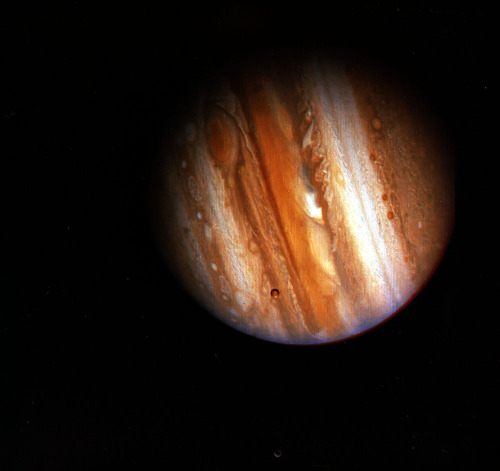Sidusglacies - ⚡️

More Posts from Sidusglacies and Others

On February 5, 1979, Voyager 1 made its closest approach to Jupiter since early 1974 and 1975 when Pioneers 10 and 11 made their voyages to Jupiter and beyond.
Credit: NASA

The speed of light between Earth and Moon in real time
via reddit
Polar Vortex Disruption Of January 2013
Satellite imagery of the disruption of the polar vortex in the northern hemisphere winter 2012-2013. The data show a major stratospheric sudden warming (SSW) event, linked to the distortion and reversal of the normal westerly (moving west to east) flow of air.
The large vortex (bright) over the North Atlantic Ocean at the start of the clip breaks up into several smaller vortices. This is due to air from lower latitudes (dark) becoming entrained in the polar flow, forming an anti-cyclonic region (dark, rotating clockwise) over Japan and eastern Russia, which disrupts the flow across the region.
Learn More About The Polar Vortex
Although dramatic, such events are not rare, occurring every two years on average. They can cause winds to reverse near the surface too, leading to very cold spells, especially in North America and Europe.
The brightness indicates the potential vorticity of the air, a measure of its rotation within its flow, at an altitude of 35 kilometers. Brighter regions have more vorticity.
A major SSW occurs when the temperatures in the stratosphere around the pole increases by at least 25 Kelvin within a week, causing the wind to change direction.
The data were gathered by the GEOS-5 satellite every hour between 15th December 2012 and 28th January 2013.
© GMAO / GSFC / NASA / Science Source

☄️ ☄️ ☄️

two of my favorite things!! pins and space!! peak goblin performance is having at least one surface covered in pins.

#TBT to 1989 when Voyager 2 spotted Uranus looking like a seemingly perfect robin’s egg. 💙 When our Voyager 2 spacecraft flew by it in this image, one pole was pointing directly at the Sun. This means that no matter how much it spins, one half is completely in the sun at all times, and the other half is in total darkness.. Far-flung, Uranus – an ice giant of our solar system – is as mysterious as it is distant. Soon after its launch in 2021, our James Webb Space Telescope will change that by unlocking secrets of its atmosphere. Image Credit: NASA/JPL-Caltech
Make sure to follow us on Tumblr for your regular dose of space: http://nasa.tumblr.com



Where cold and warm air meet, our atmosphere churns with energy. From the turbulence of supercell thunderclouds to the immense electrical discharge of lightning, there’s much that’s breathtaking about stormy skies. Photographer Dustin Farrell explores them, with a special emphasis on lightning, in his short film, “Transient 2″.
As seen in high-speed video, lightning strikes begin with tree-like leaders that split and spread, searching out the path of least resistance. Once that line from cloud to ground is discovered, electrons flow along a plasma channel that arcs from sky to earth. The estimated temperatures in the core of this plasma reach 50,000 Kelvin, far hotter than the Sun’s surface. It’s this heating that generates the blue-white glow of a lightning bolt. The heating also expands the air nearby explosively, producing the shock wave we hear as a crash of thunder. (Images and video credit: D. Farrell et al.; via Colossal)

Saturn as seen from its moon Enceladus, illustrated by Chesley Bonestell, 1972.

-
 transkeiichi liked this · 2 months ago
transkeiichi liked this · 2 months ago -
 ufo-logist reblogged this · 2 months ago
ufo-logist reblogged this · 2 months ago -
 donpanictowel reblogged this · 1 year ago
donpanictowel reblogged this · 1 year ago -
 spacepiratenemo liked this · 1 year ago
spacepiratenemo liked this · 1 year ago -
 inthesupersargassosea reblogged this · 2 years ago
inthesupersargassosea reblogged this · 2 years ago -
 alienzz-1996 reblogged this · 3 years ago
alienzz-1996 reblogged this · 3 years ago -
 yoshiwizarding liked this · 3 years ago
yoshiwizarding liked this · 3 years ago -
 puppyfluttershy liked this · 3 years ago
puppyfluttershy liked this · 3 years ago -
 panoptinomicon reblogged this · 4 years ago
panoptinomicon reblogged this · 4 years ago -
 lsdegenerate liked this · 4 years ago
lsdegenerate liked this · 4 years ago -
 obsessedwithaliens liked this · 5 years ago
obsessedwithaliens liked this · 5 years ago -
 testarossa808 liked this · 5 years ago
testarossa808 liked this · 5 years ago -
 sidusglacies reblogged this · 5 years ago
sidusglacies reblogged this · 5 years ago -
 sendintheleader reblogged this · 5 years ago
sendintheleader reblogged this · 5 years ago -
 originalclamweaselalien liked this · 5 years ago
originalclamweaselalien liked this · 5 years ago -
 ollieollieollie-oioioi liked this · 5 years ago
ollieollieollie-oioioi liked this · 5 years ago -
 houseofwolvess liked this · 5 years ago
houseofwolvess liked this · 5 years ago -
 bestusername-89 liked this · 5 years ago
bestusername-89 liked this · 5 years ago -
 zorvm reblogged this · 5 years ago
zorvm reblogged this · 5 years ago
